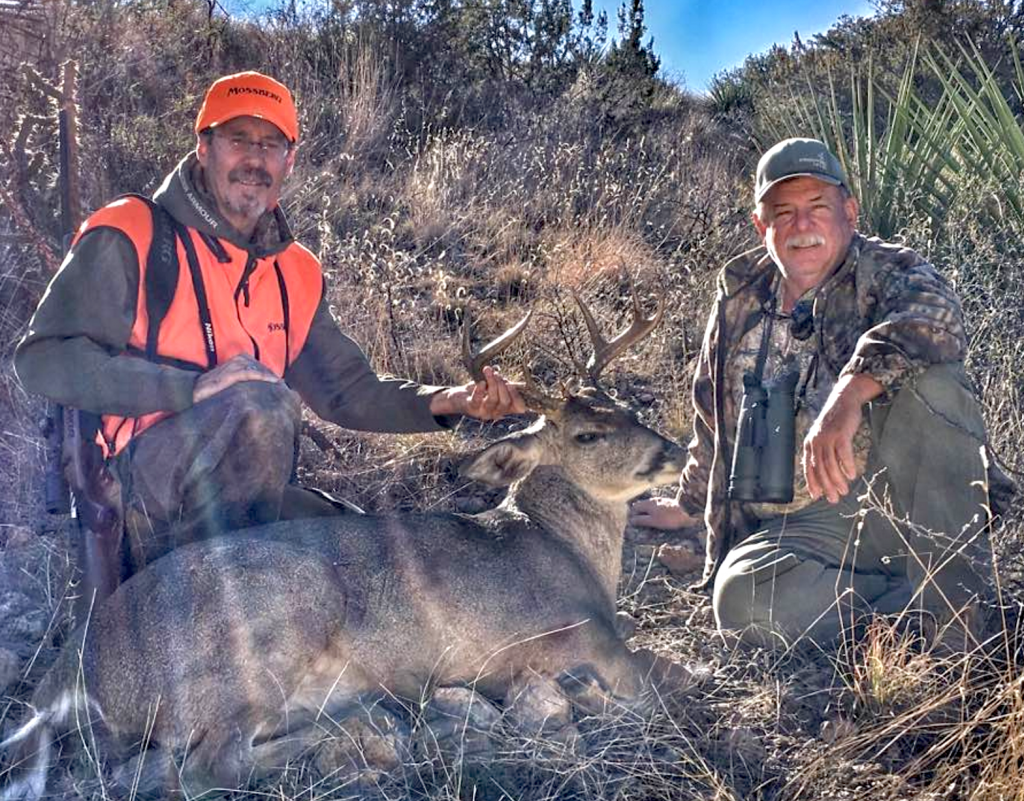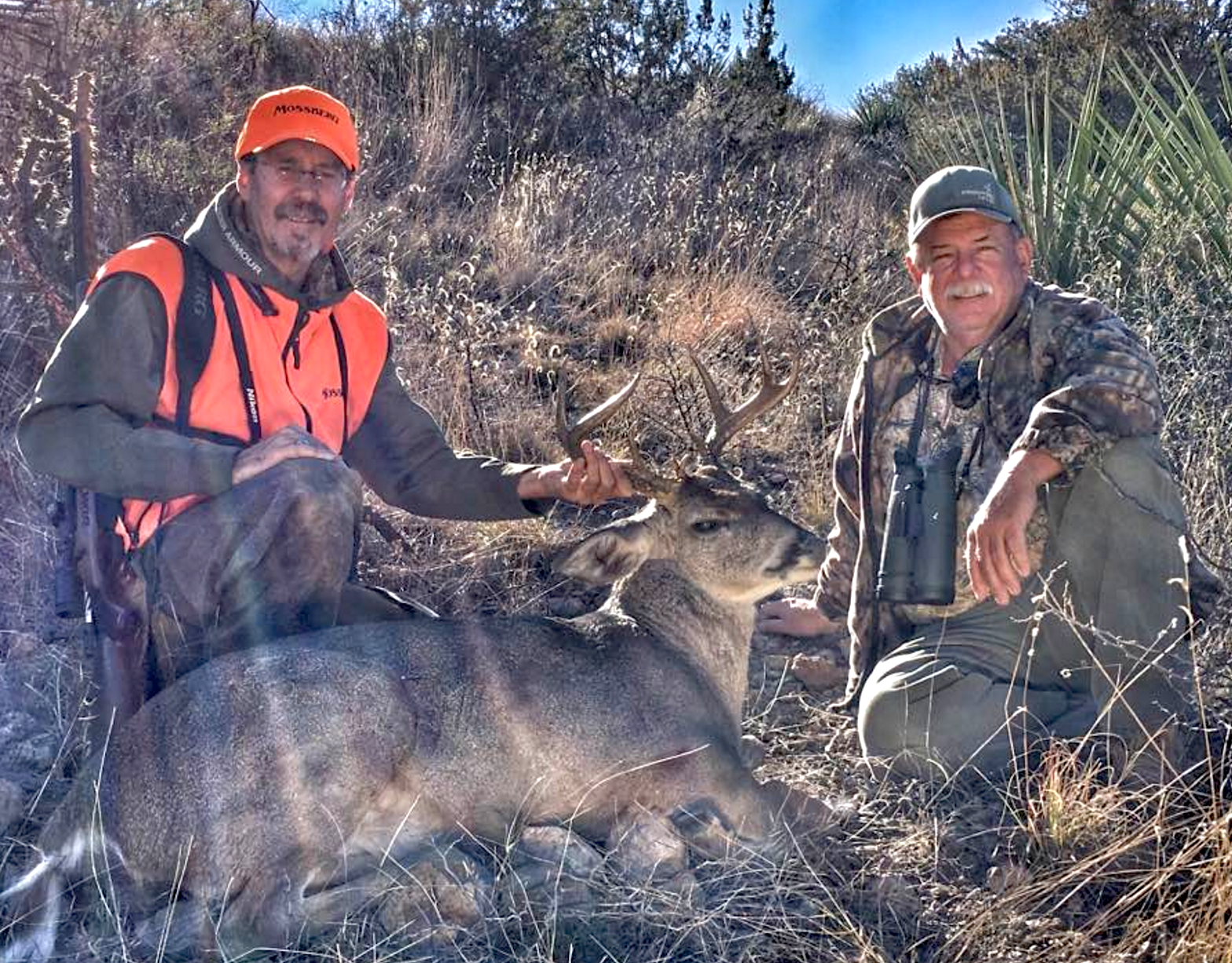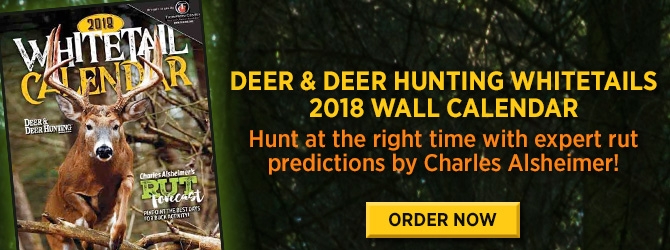
Sometimes a buck in the hand is worth so much more than one that’s taking you on a wild goose chase.
Big Red,” Steve Jones’ vintage (I’m being kind) 1-ton Dodge truck ambled along the rock-strewn road, bucking like a Brahma bull while simultaneously pitching from side to side. Inside the cab we were doing the same. But the rough ride only fueled my optimism. I knew that the dim ranch road would deposit us in some of the gnarliest mountain terrain southwest Texas has to offer. A place where, I hoped, my bucket-list buck would be waiting.
We saw our boy at first light, and Steve eased the truck to a stop and killed the engine. Even at several hundred yards away, we could see the buck’s headgear as he topped a distant hill, silhouetted against the nickel-plated sky. A quick look through the spotting scope confirmed he was the caliber of buck we were after, a clean 4×4 with prominent eye guards and good mass — would probably go better than 100 inches!
Did I mention we were hunting Carmen Mountain whitetails — those tiny deer that inhabit remote regions of southwest Texas and adjoining Mexico? Yep, 100 inches of bone would do just fine!
The buck was with a couple of does and casually followed them up and over the crest of the hill and then dipped out of sight. All we could do was watch them disappear. “They’ll probably drop down the other side a bit and bed down for the day,” Steve said, packing up the spotting scope.
It had been unseasonably warm the past few days, with a full moon that lit up the nighttime landscape like a giant floodlight. The local deer — bucks and does alike — were partying all night and sleeping all day. Kind of like rock stars. “Let’s just ease out of here and look over some other ground,” Steve said as he fired up Big Red. “We can come back here before dark — maybe from the other side — and see if we can’t get back on him.”
BIG FUN IN A SMALL PACKAGE
Hunting Carmen Mountain whitetails is unique in many ways. You’re basically chasing a whitetail subspecies that’s about the size of a large dog in some of the most despicable terrain imaginable, where all sorts of creepy crawlers bite or sting and prickly cacti and thorny bushes poke and prod.
These little deer were first described in literature in 1940, as smaller in stature, with smaller antlers, than other whitetails found in South Texas — roaming the Sierra Del Carmen Mountain range of Coahuila, Mexico; thus its name. Later, biologists described smallish whitetails inhabiting isolated mountain regions on both sides of the Mexican/American border.

The Carmen Mountain whitetail has features similar to those of its more common cousin, the Coues’ deer, but comes in a slightly smaller package. A mature buck weighs about 110 pounds on the hoof and stands approximately 33 inches tall at the shoulders. Carmen Mountain bucks have antlers similar to those of Coues’ deer, but can actually be a little larger. A buck scoring 80 to 100 inches is a good buck and a buck scoring 110 or more inches is, without a doubt, a trophy. In most cases, bucks have typical antlers with 8 points or less, although some rare non-typical bucks have been killed. Only the Safari Club International recognizes the Carmen Mountain whitetail as a separate trophy.
My guide and good friend Steve Jones owns and operates Backcountry Hunts, a one-stop shop for all sorts of big game hunting, including the elusive Carmen Mountain whitetail. “We’re less than 20 miles from the Rio Grande River,” he pointed to the south, where the jagged mountain landscape morphed into a vast river valley. A tethered observation balloon hanging on the horizon — the U.S. Customs and Border Protection’s “Eyes in the Sky,” used to monitor illegal border activity — punctuated the fact that we were on Mexico’s doorstep.
Steve explained that this hunt is more about the experience and adventure than headgear, and that hunters who come here to hunt these deer need to keep things in perspective.
“If a guy wants to kill a 200-inch whitetail, this is not the deer you’re looking for,” he said. “They’re very small and very unique. A 100-inch Carmen buck is a good trophy. But if a guy wants a really neat hunting experience similar to hunting Coues’ deer, this is the deer for you.”
And like Coues’ deer, Carmen Mountain deer are experts at using the mountainous landscape — terrain that’s unfriendly to two- legged predators — to elude danger. Like all whitetails, their nose is their first line of defense, but they also rely heavily on their vision to detect any threat. And, like the great Harry Houdini, they are masters of escape — their brown-gray bodies blending in seamlessly with the drab Texas landscape. So well, if fact, that a deer can be standing in the open one second and disappear from sight the next.
This is the consummate spot-and-stalk hunt, where good optics are a hunter’s best friend. Because these little buggers are so hard to spot, and the fact that a few inches of bone can mean the difference between a good buck and a great buck, it’s best to let your optics do some of the “walking.”
A typical morning begins with a pre-dawn ride in the truck, where you gain elevation and use a good bino to pick apart the Texas terrain. If you see a buck that shows promise, out comes the spotting scope for a closer look. Once it has been determined that you’re looking at a shooter buck, the fun begins — typically a long hike to circle above or across a slope from the deer, where you can get a clear shot. And you’ll be happy you spent those extra hours — and extra ammo — at the shooting range during the summer. A typical shot at a Carmen buck often stretches beyond 300 yards.
OH, NO! WE’RE BUSTED!
After a somewhat uneventful day, we caught up with the buck we’d seen in the morning — not 50 yards from where we had left him, just down from the crest of the hill. We sat in Big Red and watched him for a while, weighing our options. Light was fading, and if we were going to move on him we had to get going.
We started up the hill, using the rolling terrain to stay out of sight, but our stalk was quickly cut short when we spooked a bunch of cattle that ran straight up the hill toward the deer. Dejected, we turned back toward the truck. Always the optimist, Steve slapped me on the back. “You know what this means, don’t you?” he smiled. “It means we get to hunt another day.” And I was OK with that.
The next morning we decided to try something different. Steve wanted to check out an area closer to camp, where they’d seen some good bucks in the past. We got up high before the sun cut the horizon and broke out the big glass. We weren’t there a half- hour when Steve spotted two decent bucks — one as good as the other. They were on a ranch road across the draw from us — maybe 1,000 yards away — and we quickly wrote up a game plan that would close the ground between us. We drove the truck to the bottom of the draw and then got out and started working toward them.
We were sneaking up the dim road where we’d seen the deer earlier when Steve suddenly tapped me on the shoulder, “Buck! Buck!” I looked over and spotted a buck standing in a draw about 200 yards away. Unfortunately it was a fork horn. We continued up the hill, but the bucks we’d spotted from up on top had given us the slip.
WATCH: WHY WHITETAIL DEER HUNTERS SHOULD LEARN TO HUNT MULE DEER
BUSTED AGAIN
By now it was mid-morning and starting to heat up, so we cruised by camp, grabbed a quick lunch and drove across the ranch to where we’d left the 4×4 buck the previous evening. We got there with a couple of hours of shooting light left, and it didn’t take long to locate him — right where we’d left him. Trouble was, it would be difficult to get to him because of the open terrain and there wasn’t a breath of wind. We’d talked about circling to the north, which seemed to be the way the deer were slowly moving — the way they departed the previous evening — but, for whatever reason, we decided on a frontal approach again, working up a series of benches to try to get up above the buck where we hoped to slip into position for a shot.
Of course the deer meandered to the north. There was absolutely no wind and we had ground to make up — a fatal combination as it turned out. Every time we kicked a stone or stepped on a twig the deer would snap their heads up and look over in our direction. Finally, they’d had enough and busted out … to the north. So we took the long walk of shame back down the mountain. “You know what the definition of stupid is, don’t you?” Steve asked as we climbed into Big Red and he fired up the engine. “Doing the same thing over and over and expecting a different result.”
PLAN B PAYS DIVIDENDS
The next morning we decided to go back after the two bucks we’d seen the previous day. We weren’t there an hour when we spotted what looked like a pretty decent buck. He was with a doe on the next ridge over, 800 or so yards away, and Steve got the spotting scope on him. “I think we need to get after that buck,” he said, moving over so I could take a look. I happily agreed.
Steve maneuvered Big Red around to the other side of the ridge, and parked in a dry wash where we could walk in along the base of the mountain undetected. Our plan was to climb the ridge across from the deer where we hoped we could work into range and get a clear shot. Just like the previous day, there wasn’t a wisp of wind and we were going to have to be careful and take our time. Steve leaned over as we eased up the wash. “The word of the day is patience,” he whispered.
We’d been shuffling along for better than a half-hour when Steve tapped me on the shoulder and pointed up a steep incline. “Let’s sneak up there and see if we can spot him,” he said. It was a pretty nasty climb, and I grimaced every time we loosened a rock, fearful we were giving away our approach. I was easing over the rocky rim of the hill when I spotted the doe calmly feeding on a slope on the opposite ridge, 200 or so yards away. I was thinking we were in a pretty good position, but we still needed to crest the rise so that I could get down on the sticks and prepare for the shot. Mind you, we hadn’t seen the buck yet. We assumed he was in a brush thicket next to the doe — probably bedded.
Neither Steve or I are young men anymore, but we did our best coyote crawl and slipped into position. Once I got up on the sticks and zeroed in on the doe I felt like, OK, I’m rock solid, we’ve got a good opportunity to kill this buck. All we needed was for him to get up and move out into the open.
I was focused on the doe, when Steve tapped my shoulder. “There’s the buck, there’s the buck! Right above the doe.” Amazing! I don’t know how he got there without me seeing him, but all of a sudden there he was, big as life — standing broadside. He started quartering up and away and I didn’t waste any time getting the crosshairs on him. I didn’t want to risk him disappearing again. I tugged the trigger and heard the bullet impact. It was the greatest feeling in the world, as I watched my bucket list buck tumble down the hill.
When I walked up to the buck laying in a heap at the bottom of the draw, I couldn’t have been more thrilled. I’d made a great shot on what was a very nice buck with good mass and lots of character. It had been a very tough week — enjoyable, but tough. Extremely warm temps and a moon so full and bright you practically had to wear sunglasses at night. The rugged terrain. The elusive deer. The challenging shot. But it finally hit home that I’d killed my first ever Carmen Mountain whitetail when I reached down and touched his antlers. All the emotions — the feel- ing of relief, the sense of accomplishment, the joy — came to the surface right then and there.
— Gordy Krahn grew up hunting whitetails in northern Minnesota. He is Editor of Deer & Deer Hunting magazine and co-host of D&DH-TV.


